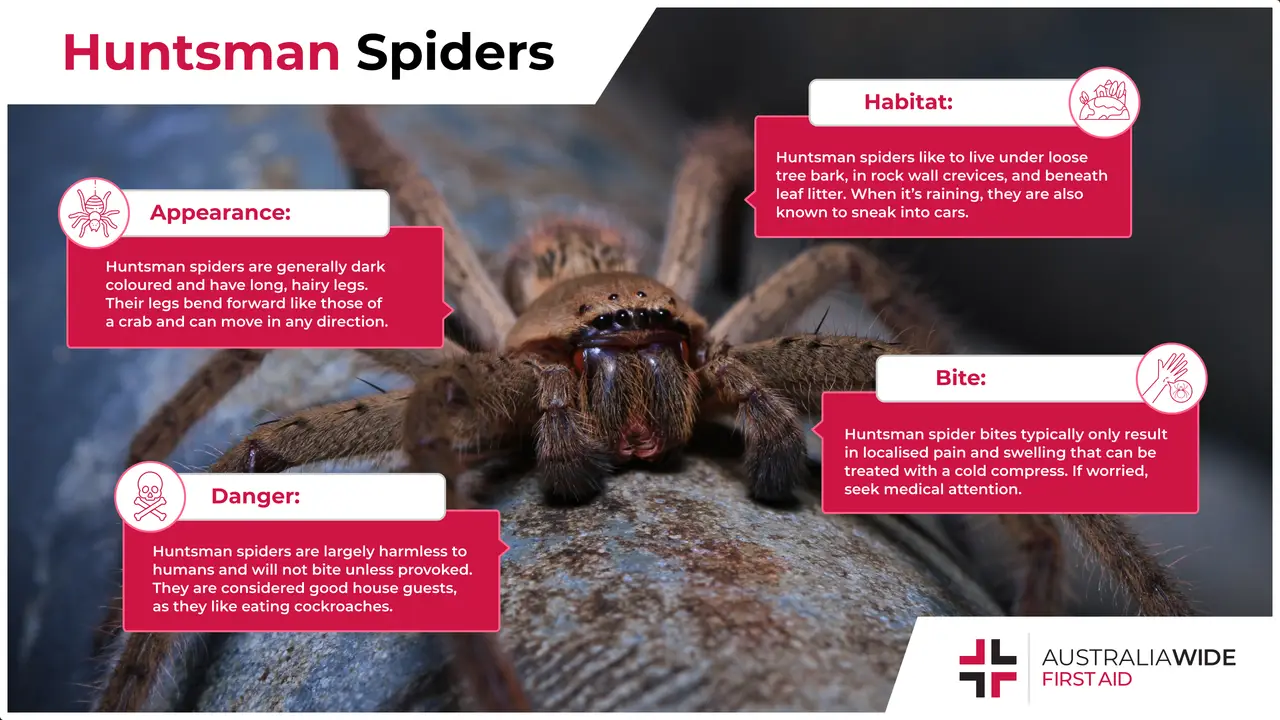The Huntsman Spider: Australia's Scariest Arachnid


If there’s one spider that can strike fear into the hearts of arachnophobes and non-arachnophobes alike, it’s the dastardly Huntsman spider.
Found in most states and territories across Australia, Huntsman spiders are notorious for their speed, agility, and their penchant for hiding in homes and cars.
But are Huntsman spiders, with their eight eyes and whooping leg span of 15cm, truly something to be feared? Let’s take a closer look at whether this spider really is all bark and no bite.
Huntsman spiders belong to the Sparassidae family, which was formerly known as the Heteropodidae family.
Huntsman spiders can be found in many warm climates across the world, including Africa, the Americas, and much of Australasia.
According to Australian Geographic, there are about 94 different species of Huntsman spiders known to occur in Australia, though it’s believed that many more are yet to be formally discovered.
Unlike most spiders, Huntsman spiders do not weave webs to catch their preferred food of insects and other invertebrates – rather, these nocturnal predators prefer to run down their prey, or to pounce on them when the time is just right.
Most Huntsman spiders are dark coloured to support their nocturnal feeding habits.
Their most distinct feature is their long, hairy legs – unlike other spiders, their legs bend forward like those of a crab, and so they can move in any direction with great speed.
In further evidence of their ability to make a quick getaway, many Huntsman spiders have flat bodies for hiding in narrow spaces.
Most of Australia’s Huntsman species are widely distributed across the country.
In the wild, they typically use their flat body to live under loose tree bark, in crevices on rock walls, and beneath rocks, logs, and other litter.
They also use their flat body to weasel into homes and cars when it’s raining, or when conditions are humid.
Despite their fearsome appearance, Huntsman spiders are largely harmless to humans, and they will not bite unless provoked.
Compared to other spiders, Huntsman spiders are relatively friendly – for instance, females rarely attack males during the mating process, and Delena cancerides, ‘the Communal Huntsman’, are known to live peacefully in large colonies that share prey and raise offspring together.
In fact, Backyard Buddies touts the Huntsman Spider as a “great natural insecticide” to keep around the home, as they like to eat cockroaches.
Huntsman spider bites typically only result in localised pain and swelling that can be treated with a cold compress.
In saying that, one species, Neosparassus diana, ‘the Badge Huntsman’, is known to inflict a bite that can cause severe localised pain and swelling, alongside sweating, nausea, and vomiting.
In the event of a Huntsman spider bite, consult the following first aid procedure:
If the pain persists or you are worried about your symptoms, it is best to seek medical attention.
If the casualty begins exhibiting signs of a severe allergic reaction, otherwise known as anaphylaxis, call Triple Zero (000) for an ambulance, consult the Australian Resuscitation Council's anaphylaxis treatment guideline, and follow DRSABCD and be prepared to perform CPR.
Huntsman spiders are found across Australia, and they regularly wander into homes and cars during times of rain and humidity.
Despite their fearsome appearance, Huntsman spiders are relatively harmless to humans, and they prefer to feast on cockroaches and other insects.
If you get bitten by a Huntsman spider, do not panic – though they may look like something out of a horror film, they do not cause horror injuries. Simply manage the pain with a cold compress and watch for signs of deterioration or anaphylaxis.
If you would like to learn more about providing first aid in the event of a spider bite, book a First Aid course with us today.
We also have articles on what to do if you get stung or bitten by a snake, fire ant, and different types of marine life.
And for more details on how to identify and treat bites from some of Australia's deadliest spiders, including White tail spiders, head to our Resource Library.
Disclaimer: This article is for informational purposes only. It does not constitute, replace, or qualify as any form of first aid training.

March 11, 2025
Darwin, the tropical capital of Australia’s Northern Territory, is home to a rich diversity of wildlife - including an impressive array of spiders. From the sprawling webs of golden orb-weavers to the cryptic camouflage of trapdoor spiders, these arachnids play a vital role in the local ecosystem. While some may inspire fear, the majority are harmless and even beneficial, helping to control insect populations.

September 4, 2024
Cat bites, while often underestimated, can lead to serious health complications if not treated promptly and properly. Cats' mouths harbour a variety of bacteria that can cause infections in humans.

April 1, 2024
Encounters with wildlife can often be thrilling, but when it comes to the creature known as the drop bear, the experience can quickly turn dangerous. A sharp increase in recent attacks prompts the need for understanding proper first aid procedures in case of an attack.